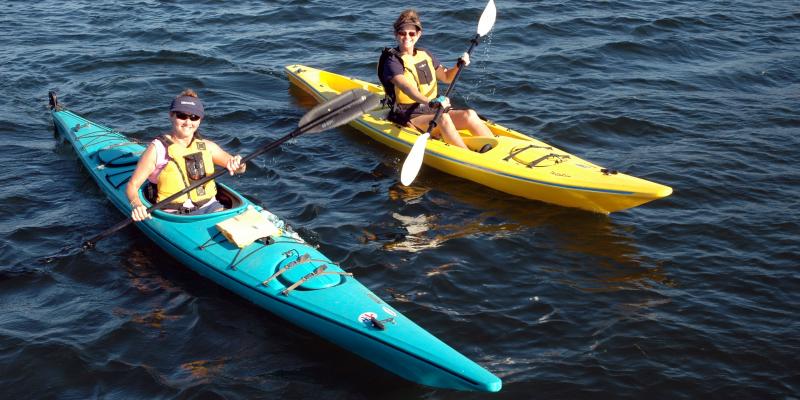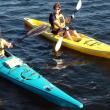Paddle smart, paddle safe, have fun
 Whether you’re a serious, long distance kayaker or just enjoy getting out on the water to relax, being safe doesn’t take away any of the fun. Paddle sports have become extremely popular in the last few years and while they comprise only 7 percent of vessels, paddle craft account for 28 percent of boating fatalities nationwide. The statistics in the First Coast Guard District are much worse: in 2016, 29 of 49, or 59 percent, of all recreational boating fatalities involved paddle craft. USCG Photo
Whether you’re a serious, long distance kayaker or just enjoy getting out on the water to relax, being safe doesn’t take away any of the fun. Paddle sports have become extremely popular in the last few years and while they comprise only 7 percent of vessels, paddle craft account for 28 percent of boating fatalities nationwide. The statistics in the First Coast Guard District are much worse: in 2016, 29 of 49, or 59 percent, of all recreational boating fatalities involved paddle craft. USCG Photo
 Whether you’re a serious, long distance kayaker or just enjoy getting out on the water to relax, being safe doesn’t take away any of the fun. Paddle sports have become extremely popular in the last few years and while they comprise only 7 percent of vessels, paddle craft account for 28 percent of boating fatalities nationwide. The statistics in the First Coast Guard District are much worse: in 2016, 29 of 49, or 59 percent, of all recreational boating fatalities involved paddle craft. USCG Photo
Whether you’re a serious, long distance kayaker or just enjoy getting out on the water to relax, being safe doesn’t take away any of the fun. Paddle sports have become extremely popular in the last few years and while they comprise only 7 percent of vessels, paddle craft account for 28 percent of boating fatalities nationwide. The statistics in the First Coast Guard District are much worse: in 2016, 29 of 49, or 59 percent, of all recreational boating fatalities involved paddle craft. USCG Photo
“Believe me, young friend, there is nothing, absolutely nothing, half so much worth doing as simply messing about in boats,” so says Ratty in Kenneth Graham`s famous children’s novel, "The Wind in the Willows."
Many of us agree completely with Ratty, there is nothing so fine as being on the water, especially in a small manually propelled craft. The feeling of freedom, self-sufficiency and the ability to slow down and enjoy the water cannot be matched in any other type of vessel.
As enjoyable as spending a day paddling on Maine’s pristine waters may be, there’s been an alarming increase in recreational boating deaths last year and into this year. A disproportionate number of these fatalities have involved paddle craft, and the majority of victims were not wearing life jackets.
State and federal regulations for all vessels, including all paddle craft, canoes, kayaks and stand up paddle boards, require a Coast Guard approved life jacket and sound producing device for each person such as a whistle or manual horn. It cannot be over-emphasized that it does little good to have a life jacket on board that’s not being worn all the time. It must be worn to be effective. It’s extremely difficult to don a life jacket once in the water and virtually impossible after even a very few minutes in cold water where muscle function quickly fails. Life jackets save lives.
Some more tips that may save your life:
- Don’t paddle alone, it’s often more fun and far safer to paddle with others. At least one person in your group should have a handheld Marine VHF radio or at the very least, a cell phone in a waterproof case. Having a handheld GPS can be a life saver, as well, when the fog rolls, in as it often does, with only a few minutes warning.
- Always check the weather before you head out and have a way of checking weather while on the water. “Checking the weather” also means checking the water temperature; it’s the middle of June and the water temperatures in Boothbay Harbor are just past the 50 degree mark, water temperatures that are deadly in a short period of time.
- Wear your life jacket at all times and dress in layers so you’ll be prepared for heat or cold regardless of what the air temperature was when you set out.
- Know your limits, be conservative; the motion of the sea and sun can be surprisingly fatiguing. Add in possible hunger and dehydration, and fatigue may occur much more quickly than expected. Always turn around and head for home before you get tired, if the wind or tide has changed, it could be “up hill” all the way back to the dock.
- File a float plan with a reliable friend or at the paddle craft rental location and stick to it. A float plan doesn’t have to be complicated, just telling someone where you’re going and when you expect to be back can make a huge difference in keeping you safe.
- Once again…ALWAYS wear your life jacket, with so many comfortable styles and types available there is really no excuse for not wearing one all the time.
- If your paddle craft is not clearly marked with your name and contact information, or the name of the rental outlet, make sure to get that done. Each year the Coast Guard expends millions of dollars and too many hours trying to determine if a vessel adrift with no one on board floated away from a dock unoccupied or is a “person in the water” Search and Rescue emergency. The Coast Guard and Coast Guard Auxiliary have free waterproof paddle craft ID stickers they’ll be happy to give you.
None of the above should detract from your fun on the water, on the contrary, following these simple guidelines should add to your confidence, enjoyment and safety on every outing.
Have fun! Stay safe! See you on the water!
The Coast Guard Auxiliary is the uniformed civilian component of the U.S. Coast Guard and supports the Coast Guard in nearly all mission areas. The Auxiliary was created by Congress in 1939. For more information, please visit www.cgaux.org
Event Date
Address
United States






















